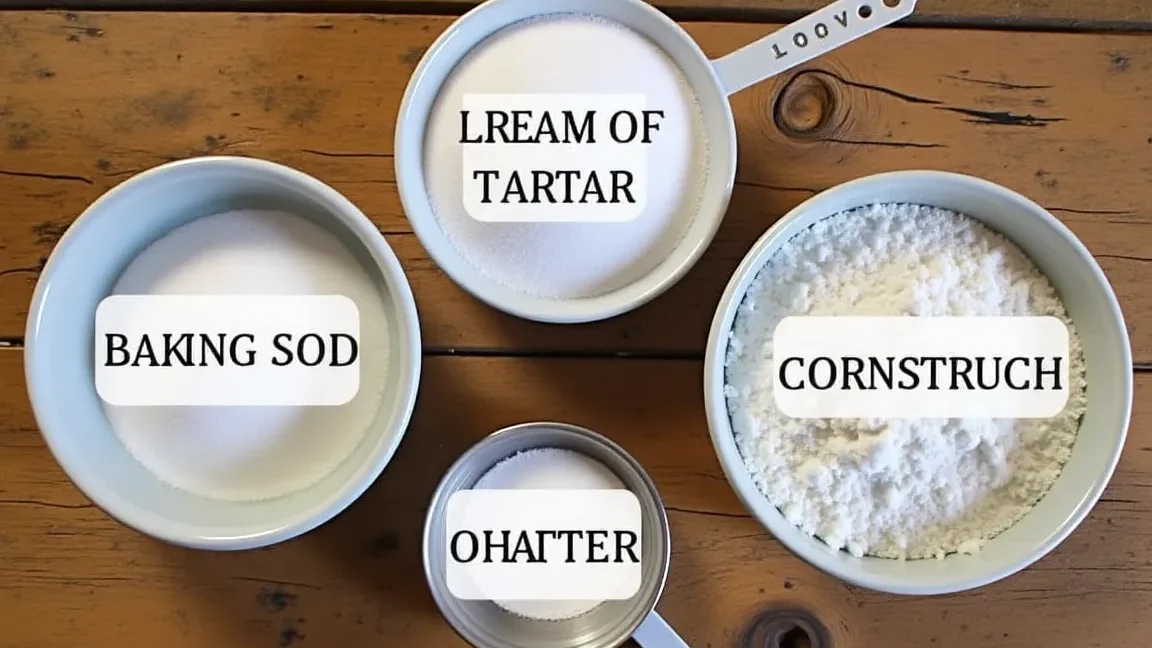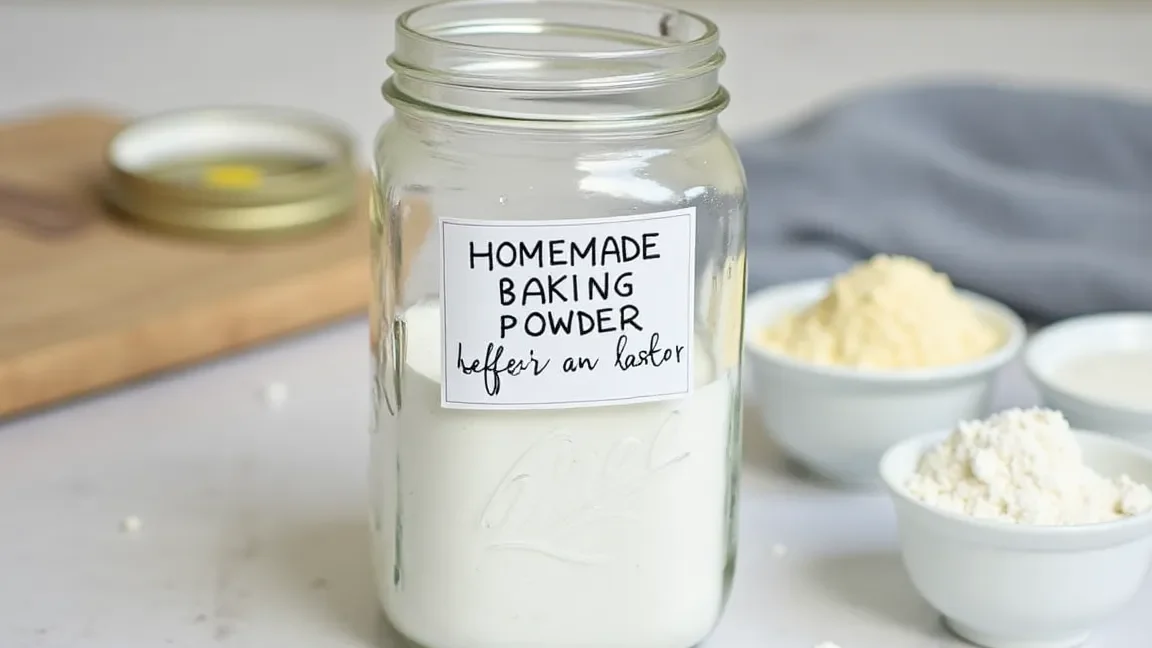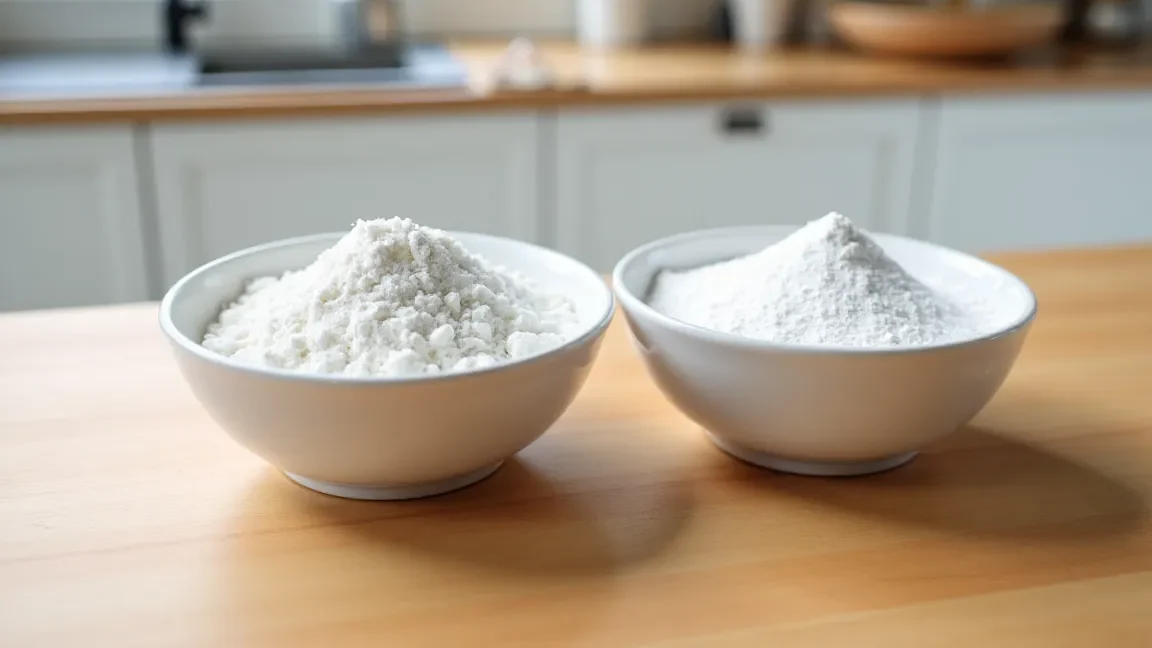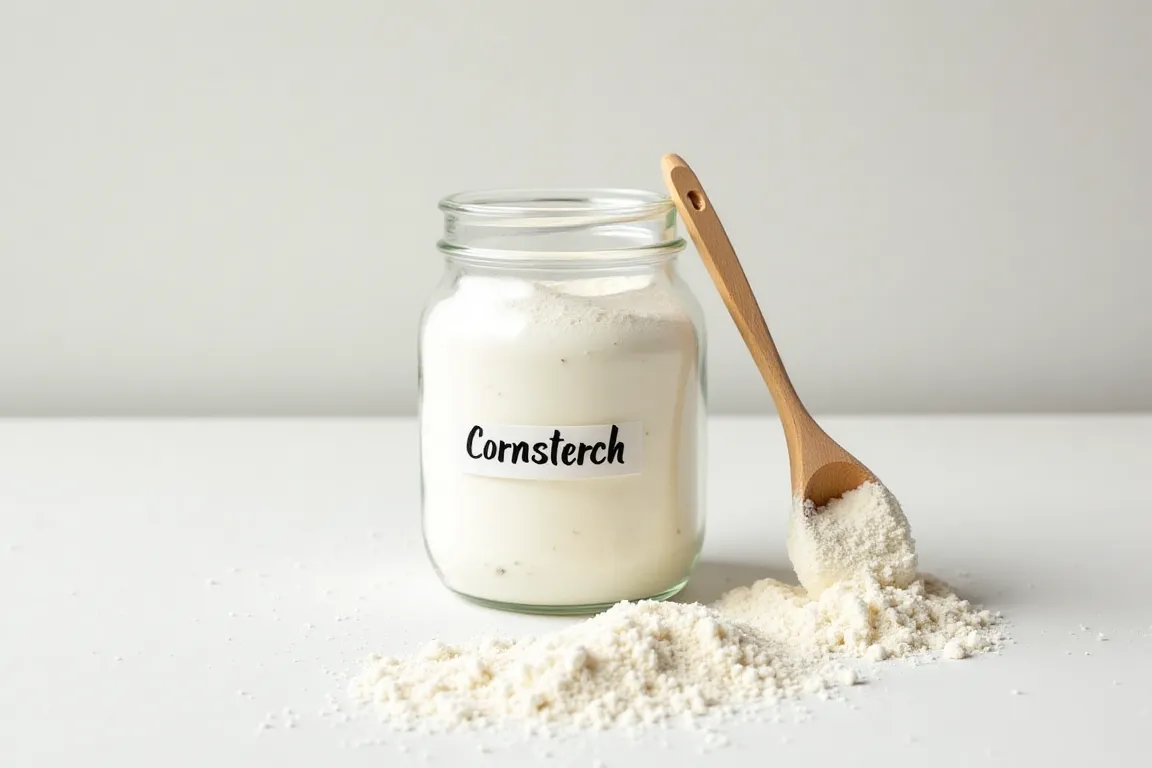This guide answers the question: “Can I use cornstarch instead of baking powder?” We’ll compare their uses and effects on baked goods and suggest alternatives if you’re out of baking powder.
Table of Contents
Understanding Baking Powder
What is Baking Powder?
Baking powder is a special mix of baking soda and an acid that helps baked goods rise. It’s like a tiny, powerful leavening agent.
How Baking Powder Works
If you add water to baking powder there is a chemical reaction that takes place. This creates carbon dioxide bubbles, which get trapped in the dough or batter. The bubbles make the baked goods puff up and become light and fluffy. This process gives cakes and muffins their airy texture.
Baking Soda and Acid
The baking soda and acid in baking powder work together. The acid could be things like cream of tartar or other similar compounds. When mixed with a liquid, they react to create those critical carbon dioxide bubbles. Without both, the baking powder wouldn’t work.

Understanding Cornstarch
What is Cornstarch?
The Cornstarch powder is fine white powder that is made of corn. It is used to thicken sauces, soups, and other foods.
How Cornstarch Thickens
Cornstarch molecules absorb water, creating a thicker, gel-like consistency. Think of it like tiny sponges soaking up liquid. The more cornstarch you add, the thicker it gets.
Cornstarch vs. Baking Powder
Cornstarch and baking powder are very different. Cornstarch thickens while baking powder makes things rise. You can’t use cornstarch to replace baking powder in recipes that need to increase; using cornstarch instead will result in a flat, dense baked good.
Comparing Baking Powder and Cornstarch
Different Uses
Baking powder makes baked goods rise, while cornstarch thickens liquids. They have completely different jobs. Baking powder adds air, while cornstarch absorbs water.
How They Work
Baking powder uses a chemical reaction to create carbon dioxide bubbles. These bubbles make cakes and muffins light and fluffy. Cornstarch works differently. Its tiny particles soak up water, making sauces and soups thicker.
Why You Can’t Substitute
You can’t use cornstarch instead of baking powder. Cornstarch won’t make your baked goods rise. It will only make them thicker and denser. Using cornstarch instead of baking powder will result in a flat, heavy baked good. They are not interchangeable.
A Simple Analogy
Imagine trying to build a tall sandcastle. Baking powder is like adding air to make the sandcastle tall, while cornstarch is like adding wet sand, making the sandcastle heavier and shorter. They achieve completely different results.

Recipes That Use Cornstarch
Thickening Sauces and Gravies
Cornstarch is great for thickening sauces and gravies. It works by absorbing water. The more cornstarch you add, the thicker your sauce becomes. Many beef stew or gravy recipes use cornstarch to create a smooth, rich consistency.
Adding Texture to Desserts
Some desserts use cornstarch to change their texture. It can help create a smoother pudding or a chewier cookie. Cornstarch helps absorb extra liquid, preventing a runny dessert. It’s a common ingredient in fruit pies to avoid a soggy bottom.
Cornstarch in Other Dishes
You might find cornstarch in other foods, too. It can add thickness to soups or be used as a coating for fried foods, helping create a crispy texture. Always follow a recipe carefully when using cornstarch. Too much can make food gummy or clumpy.
Recipes That Use Baking Powder
Cakes
Many cakes need baking powder to rise. A simple vanilla cake, for example, relies on baking powder to create a light and fluffy texture. Without it the cake would be hard and flat. Recipes often list the amount of baking powder needed.
Muffins
Blueberry, cornbread, and banana nut muffins all use baking powder. It helps them puff up nicely in the oven. The baking powder reacts with other ingredients to create air pockets, giving muffins their soft texture.
Biscuits
Biscuits are another food that depends on baking powder. Baking powder makes biscuits light and flaky. The recipe will tell you how much baking powder to use. Don’t forget—you can’t use cornstarch instead!
Other Recipes
You’ll find baking powder in many other recipes, too. It is used for leavening in some quick breads, scones, and even some types of pancakes. Always follow the recipe’s instructions carefully for the best results. Remember, baking powder is different from cornstarch; you can’t substitute one for the other.

Alternatives to Baking Powder
Finding Substitutes
If you’re out of baking powder, don’t worry! There are a few things you can try, but remember, they might change the recipe’s taste and texture slightly. To understand more about how baking powder works, check out this detailed guide on baking powder.
Baking Soda and Acid
You can sometimes use baking soda and an acid. The acid could be lemon juice, vinegar, or buttermilk. However, you must carefully follow a recipe that uses this substitution, as the proportions are critical. This method isn’t always a perfect swap for baking powder.
Other Leavening Agents
Some recipes use other leavening agents like yeast. Yeast is very different from baking powder and makes things rise slowly, needing time to work. This is common for bread recipes. Don’t use yeast as a quick substitute for baking powder in cakes or muffins.
Frequently Asked Questions
Can I use more cornstarch than the recipe calls for?
Adding extra cornstarch will thicken your sauce or another recipe. Too much can make it gummy or clumpy. Always follow the recipe’s instructions.
If I make use of baking powder rather than cornstarch?
Baking powder makes things rise, while cornstarch thickens. Using baking powder where cornstarch is needed will not thicken your recipe and might change the taste.
Are there other ways to thicken sauces besides cornstarch?
Yes, you can use flour or arrowroot powder. These work similarly to cornstarch by absorbing water.
What if I don’t have any baking powder or substitutes?
Some recipes might work without a leavening agent, but your baked goods will likely be flat. It’s best to have a baking powder substitute on hand or find a recipe that doesn’t need it.
Is cornstarch gluten-free?
Yes, cornstarch is naturally gluten-free.
Can I use cornstarch to make my beef stew thicker?
Cornstarch is a common ingredient in beef stew and similar recipes. It is mixed with cold water before being added to the hot stew.
Besides thickening, what else is cornstarch used for?
Some desserts use cornstarch to improve texture. It can also be used as a coating for fried foods to help make them crispier.
Conclusion:
Key Differences Summarized
Cornstarch thickens; baking powder makes things rise. They work in entirely different ways. Cornstarch absorbs water, creating a thicker texture. Baking powder uses a chemical reaction to produce carbon dioxide bubbles, making baked goods light and airy.
Why Substitution Fails
Using cornstarch instead of baking powder results in flat, dense baked goods. Cornstarch lacks the chemical reaction that makes baking powder work, so it won’t create the air pockets needed for cakes, muffins, or biscuits to rise correctly.
Solutions for Baking Needs
If you need to make something rise out of baking powder, you can try a mixture of baking soda and an acid, like vinegar or lemon juice. Always use a recipe that specifically guides you through this substitution. Remember, this slightly changes the taste and texture. Cornstarch is an excellent choice for thickening, but never use it to replace baking powder. Cornstarch and baking powder are not interchangeable. This guide shows you why and offers solutions.
